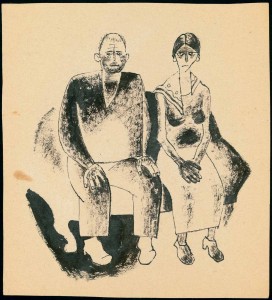Futurism had become history. But the questions that it raised, inquiries into art’s relationship to everyday culture, remained. The year 1921 saw the formation of the New Society of Painters with their new version of neoprimitivism. The first Exhibition-Forum of the Societies for Active Revolutionary Art was held in Moscow in 1924. This exhibition’s participants, graduates of the Moscow Higher Studios of Art and Technology, gathered around David Shterenberg in 1925 to form the Society of Painters and Sculptors, one of the best known artists’ societies in the 1920s, which reflected many directions in the quest to find a contemporary art idiom. Members and exhibitors of this association included such varied artists as Alexander Deyneka, Leonid Zusman, Alexander Labas, Yuri Pimenov, Andrei Goncharov and Alexander Tyshler. Another school of artists, based in Leningrad, followed Filonov and were known as the Masters of Analytic Art. Though these well-known artists’ unions did not proclaim themselves expressionists, they were to a significant degree inspired by the artistic strategy, or rather attitude, that we call “expressionistic”.
At the core of the Painter’s Guild was a group of students and graduates of the Moscow Higher Studios of Art and Technology who gathered around their teacher, Alexander Shevchenko, an insightful painter and outstanding instructor. Shevchenko was a colleague of Mikhail Larionov, but primitivism and futurism remained for him merely approaches to experiment with as he acquainted himself with the different styles of contemporary art.
Beginning in 1922, Shevchenko participated in the Makovets Society, a group of artists which produced works that are exceptionally important for analyzing the contemporary state of the art form labelled above as “spiritualistic” and directly related to the essence of “expressionism” in Russia. Among the members of the Makovets Society were several like-minded colleagues and followers of Mikhail Larionov and Wassily Chekrygin, such as Lev Zhegin, Yekaterina Belyakova and Sergei Romanovich, marvellous artists who perceived art as a spiritual practice. But in this society as well, Shevchenko remained at the sidelines of the active core of artists.
Shevchenko’s work is an almost academic examination of the post-impressionist state of the language of art language. His art is very personal, very individualistic and very lyrical. It could almost be classified as a formal and even popular imitation of Cezanne, if it were not for its profound poetry, fine technique and sheer force in harmonizing the painting’s elements. Be that as it may, neither the works of Shevchenko himself nor the products of what is known as “the Shevchenko school” have any relation whatsoever to expressionism in either style or content.



